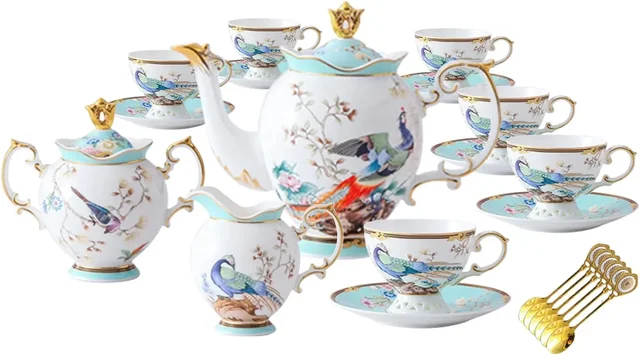
Introduction
Teapots and teapot sets are more than just vessels for brewing tea; they are integral to the tea-drinking experience, offering a blend of functionality and aesthetic pleasure. Whether you are an avid tea enthusiast or a casual drinker, the right teapot and set can enhance your enjoyment of this timeless beverage. This guide delves into the different types of tea service, their materials, designs, and tips for choosing and maintaining the perfect set for your tea rituals.
The Importance of Teapots and Teapot Sets
These serve several essential functions:
- Brewing Efficiency: A well-designed teapot ensures proper infusion, allowing tea leaves to steep and release their full flavor.
- Aesthetic Appeal: Beautiful teapots and matching sets add elegance to your tea service, enhancing the overall experience.
- Cultural Significance: Teapots often reflect the cultural heritage of tea-drinking traditions, from Chinese Yixing clay teapots to British porcelain sets.
Types of Teapots and Teapot Sets
Teapots and teapot sets come in various styles, each suited for different types of tea and occasions:
- Traditional Teapots:
- Yixing Clay Teapots: Made from the unique clay of the Yixing region in China, these teapots are prized for their ability to enhance the flavor of tea. Ideal for brewing oolong, black, and pu-erh teas.
- Japanese Tetsubin: Cast iron teapots that retain heat well, often used for brewing green tea. They come in both decorative and practical forms, sometimes lined with enamel.
- British Porcelain Teapots: Known for their elegant designs, often used for serving black tea during afternoon tea. These teapots are typically part of a larger set including cups, saucers, and a sugar bowl.
- Modern Teapots:
- Glass Teapots: Allow you to watch the tea leaves unfurl and change color as they steep. They are often used for blooming teas and come with built-in infusers.
- Stainless Steel Teapots: Durable and resistant to rust, ideal for everyday use. Many modern designs include insulated walls to keep the tea hot for longer.
- Specialty Teapots:
- Gongfu Teapots: Small teapots used in the Chinese gongfu tea ceremony. They are designed for multiple short infusions, enhancing the flavor profile of the tea.
- Moroccan Teapots: Typically made of metal and intricately decorated, used to serve mint tea in traditional Moroccan tea ceremonies.
- Teapot Sets:
- Matching Sets: Include a teapot with matching cups, saucers, and sometimes a sugar bowl and creamer. These sets are perfect for formal tea parties and gatherings.
- Travel Sets: Compact and portable, often including a small teapot and cups, ideal for tea on the go.
Materials Used in Teapots and Teapot Sets
The material of a teapot can significantly impact the brewing process and the tea’s flavor:
- Clay:
- Yixing Clay: Porous and absorbs the flavors of tea over time, enhancing the taste with each use.
- Stoneware: Non-porous and retains heat well, suitable for all types of tea.
- Porcelain:
- Bone China: Lightweight and delicate, offering excellent heat retention. Often used in elegant, decorative sets.
- Fine Porcelain: Durable and retains heat, ideal for a variety of teas.
- Glass:
- Borosilicate Glass: Heat-resistant and durable, allowing for visual appreciation of the tea’s color and infusion process.
- Metal:
- Cast Iron: Retains heat well, ideal for keeping tea warm for extended periods.
- Stainless Steel: Durable and easy to clean, often used in modern teapot designs.
- Ceramic:
- Earthenware: Rustic and retains heat well, often used in traditional and artisan teapot designs.
Choosing the Right Teapot and Teapot Set
Selecting the ideal teapot and set involves considering several factors:
- Type of Tea:
- Green Tea: Glass or porcelain teapots are ideal for delicate green teas.
- Oolong and Black Tea: Yixing clay or cast iron teapots enhance the flavors of robust teas.
- Herbal Tea: Any material can be suitable, but glass teapots allow you to enjoy the visual beauty of the infusion.
- Brewing Capacity:
- Single Serving: Small teapots or personal sets are perfect for individual use.
- Multiple Servings: Larger teapots or sets are ideal for serving several guests.
- Design and Aesthetic:
- Traditional: Choose designs that reflect cultural tea-drinking traditions.
- Modern: Opt for sleek, minimalist designs that complement contemporary decor.
- Functionality:
- Infusers: Built-in infusers or separate infusers make brewing loose leaf tea convenient.
- Heat Retention: Consider materials and designs that retain heat if you prefer your tea to stay hot for longer periods.
Maintaining Your Teapot and Teapot Set
Proper care and maintenance will extend the life of your teapot and set:
- Cleaning:
- Clay Teapots: Rinse with hot water and avoid using soap, which can affect the flavor of future brews.
- Porcelain and Glass: Clean with mild soap and water. Use a soft brush to remove any stains.
- Metal: Wipe with a damp cloth and dry thoroughly to prevent rust.
- Storage:
- Dry Completely: Ensure the teapot and all components are completely dry before storing to prevent mold and mildew.
- Safe Storage: Store delicate porcelain and glass sets in a safe place to avoid chips and cracks.
- Regular Use:
- Seasoning: Some teapots, like Yixing clay teapots, benefit from regular use, which enhances their flavor-enhancing properties.
- Avoid Sudden Temperature Changes: To prevent cracking, avoid exposing teapots to sudden changes in temperature.
Conclusion
Teapots and teapot sets are essential tools for any tea lover, offering both practical benefits and aesthetic pleasure. By understanding the different types, materials, and designs available, you can select the perfect teapot and set to enhance your tea-drinking experience. Proper care and maintenance will ensure that your teapot remains a cherished part of your tea rituals for years to come.


